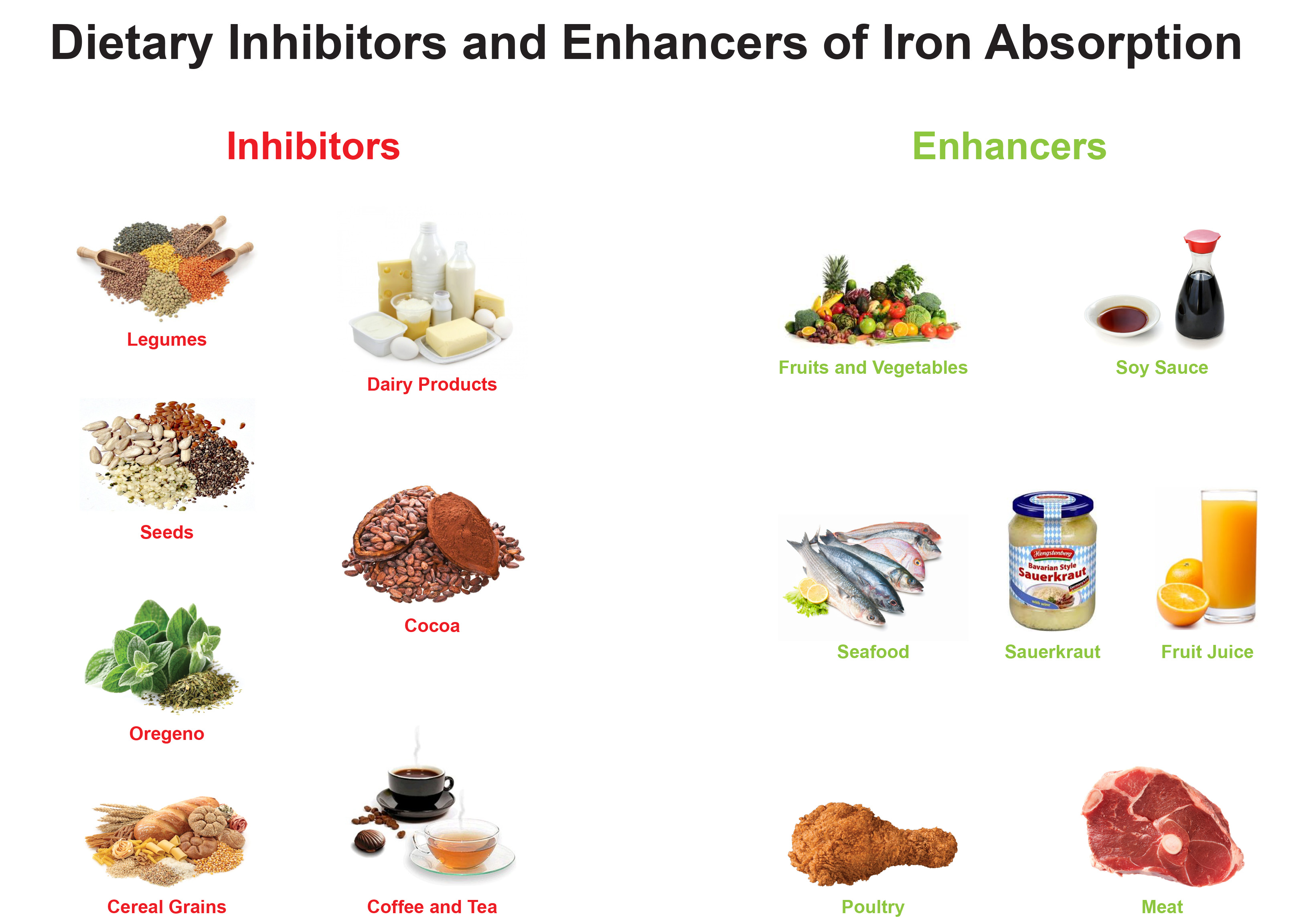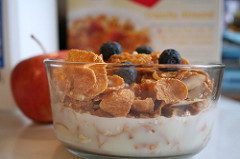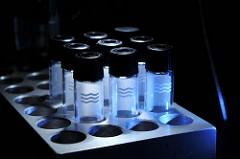With the significant, long-term consequences of IDA in infants and toddlers, including cognitive, motor and behavioral deficits, it is important to ensure the treatment strategy implemented is effective. There are numerous barriers to adequate iron supplementation, including provider/patient lack of education, cost, poor compliance, risk of iron overload and federal supplemental nutrition programs not providing iron supplements. 2 Due to the lack of compliance with standard therapies, such as ferrous sulfate drops, it is important to explore alternative iron therapies in treating infants with ID/IDA. Below are tables describing current research on alternative forms of iron with research from PubMed and Consumer Labs, a site that provides test results and reviews of vitamins, supplements, herbs and nutrition products to consumers.
| Form of Iron | Serving Size | Amount of iron per serving (according to label) | Research | Consumer Labs | |
|---|---|---|---|---|---|
| Enfamil Poly-Vi-Sol with iron | Ferrous Sulfate | 1 mL | 15 mg = 100% DV infants, 150% DV children under 4 years | Considered the standard treatment for iron deficiency. | No results |
| Nova Ferrum | Iron Polysaccharide | 1 mL | 15 mg = 100% DV infants, 150% DV children under 4 years | Worked in treating IDA, but not as well as ferrous sulfate in raising Hgb over 12 weeks of treatment (Powers)49 Results also showed that iron polysaccharide was easier to administer but had a slightly higher incidence of loose stools during treatment than ferrous sulfate (Powers)49 |
No results |
| Chelated Iron | Ferrous bisglycinate chelate | 1 tsp = 5 mL | 10 mg = 55% DV | Fewer/less intense side effects than ferrous sulfate (Jeppsen)25 Chelation of iron increases its bioavailability by preventing complex formation with phytates (Kloots)26 |
No results |
| Upspring Baby Iron + Immunity | Ferric glycinate | 1 mL | 10 mg = 67% DV infants | Unable to find any studies examining absorption in children. | No results |
| Earth’s Best Cereals | Ferric pyrophosphate | 4 tbsp = 60 mL | 45% DV | Water insoluble, poorly soluble in dilute acid. Lower bioavailability compared to ferrous sulfate (Quintaes)27 | No results |
| Zarbee’s Multivitamin | Ferrous gluconate | 2 mL | 10 mg = 67% DV infants, 100% DV children under 4 years | In a study of healthy infants given either ferrous gluconate or iron polymaltose complex, ferrous gluconate appeared to be more effective in preventing iron deficiency anemia but less tolerated. (Jaber)38 | No results |
| Floradix: iron + herbs | Ferrous gluconate | 10 mL | 10 mg = 60% DV for older children | Must be combined with fruit juice, but new AAP Policy Statement states that children under 1 year of age should not be given fruit juice (Heyman)28 | Approved of it and test results did not exceed contamination limits for lead, cadmium and arsenic |
| Floradix: liquid iron and vitamin formula | Ferrous gluconate | Pediatric dose: 5 mL | 27% DV | No results | |
| BellyBar Prenatal Vitamin | Reduced from iron pentacarbonyl | 2 chewable tablets | 27 mg = 150% DV | Unable to find any studies examining absorption. | No results |
| Gerber Rice Cereal | Ferrous fumarate | ¼ cup | 45% DV | No results | |
| Flintstones Chewable Multivitamin with Iron | Ferrous fumarate | ½ tablet for children 2 and 3 years old, 1 tablet for 4 years+ | 18 mg = 90% DV children 2 and 3 years, 100% DV children 4 years+ | When studied in pregnancy, IV iron sucrose was more effective than this form of iron, ferrous fumarate, in correcting anemia or iron store depletion (Bhavi)29 | No results |
| Vitamin Friends chewable gummy | Ferrous fumarate | 1 gummy | 15 mg = 150% DV for children ages 2-4, 83% DV ages 4+ | No results | |
| Navitco NutriBear Iron Jellies | Ferrous fumarate | 1 bear | 5 mg = 50% DV under 4 years old, 27% DV ages 4+ | No results | |
| Rite Aid Chewable Multivitamin | Ferrous fumarate | ½ tablet children 2 and 3 years, 1 tablet children 4 years of age and older | 18 mg = 90% DV 2-3 years old, 100% DV children 4 years+ | No results | |
| Liver Fractions | Heme iron | 2 capsules | 1,300 mg = DV not established | Heme iron is the most readily absorbed form of iron and is found in animal products. (Domellof)37 | No results |
| Beet Juice | 1 tsp = 5 mL | No DVs given | Taste is a concern. | No results | |
| David Winston’s Iron Extract Herbal Tonic | 60 drops | DV not established | Amount of iron depends on the preparation of the Stinging Nettle (Rutto)30 | No results | |
| Gentle Iron | Iron bisglycinate | 1 vegetable capsule | 25 mg = 139% DV | Could be associated with fewer side effects and better compliance than ferrous sulfate (Melamed)31 A study in iron-deficient children ages 6-11 found that bread fortified with iron bisglycinate was more effective than bread fortified with electrolytic iron (van Stuijvenberg)32 |
No results |
| Gerber Graduates Strawberry Apple Puffs | Electrolytic iron | 60 pieces | 10% DV infants, 15% DV children 1-4 | A study in iron-deficient children ages 6-11 found that bread fortified with iron bisglycinate was more effective than bread fortified with electrolytic iron (van Stuijvenberg)32 | No results |
| NutriPure Chewable Iron with Vitamin C | Carbonyl iron | 1 tablet (melts in mouth) | 18 mg = 100% DV (adults) | Carbonyl iron is a widely used food additive that is less toxic, more slowly absorbed and better tolerated than ferrous sulfate (Gordeuk)33 | No results |
| Lucky Iron Fish | Primarily made up of ferrous iron | N/A | N/A | Could be a safe treatment for ID as contaminants were either undetectable or below levels set by the World Health Organization. (Armstrong)35 Effective in short-term, but not longer-term against iron deficiency anemia. (Charles)36 There is a need for more research to be performed on the bioavailability of the leached iron. (Charles)36 |
No results |
Dietary Inhibitors and Enhancers of Iron Absorption
Figure below adapted from Quintaes, et al.

There are two types of iron in the diet, heme iron (from animal hemoglobin and myoglobin present in sources of animal food) and nonheme iron (inorganic iron salts present in plants, food and animal tissues). The absorption of nonheme iron is significantly lower than the absorption of heme iron, due to differing processes of absorption in the gastrointestinal tract. Dietary compounds (inhibitors and enhancers) impact the amount of iron absorbed, but they tend to have less of an effect on heme iron. The figure above displays common inhibitors and enhancers of iron absorption, which have the greatest impact on the absorption of nonheme iron but can still impact bioavailability of heme iron. Cereal grains, legumes and seeds contain phytates, which impair the absorption of iron in the gastrointestinal tract. Similarly, calcium in dairy products and polyphenols present in tea, coffee, cocoa and oregano decrease iron absorption. On the other hand, ascorbic acid (vitamin C) enhances absorption of iron from the diet and this vitamin is abundant in fruits, juices and vegetables. Fermented or germinated food/condiments (sauerkraut, soy sauce) also increase the absorption of iron through the gastrointestinal tract. Similarly, caseinophosphopeptides (CPPs) are added to fruit beverages, such as grape and orange juice, and these compounds enhance iron absorption. Therefore, it is important to determine typical foods in an individual’s diet when treating them for ID/IDA in order to educate them on which foods to increase consumption of and which foods to avoid. In addition, due to differing diets across cultures, nutritional iron recommendations vary among countries and this is an important factor to consider when caring for a diverse patient population.
World Health Organization recommendation of iron fortificant compounds for cereal foods
 |
| Photo by musicfanatic29 |
The World Health Organization (WHO) recommends ferrous sulfate, ferrous fumarate, ferric pyrophosphate and electrolytic iron powder as iron compounds suitable for cereal fortification. However, many cereals that are fortified with iron use low-cost elemental iron powders, which have low bioavailability and are not recommended by WHO.27 Though, the addition of citric or ascorbic acid to iron-fortified cereals can enhance iron bioavailability. The form of iron with the greatest bioavailability is NaFeEDTA, which does not enter the pool of nonheme iron to be absorbed. Instead, NaFeEDTA dissociates in the gastrointestinal tract to form iron (bioavailable) and a NaFeEDTA salt.27 There are numerous factors to consider when choosing an iron fortificant compound, including bioavailability, cost and shelf-life. According to a review article by Quintaes, et al., the iron fortificant compounds with the greatest bioavailability (NaFeEDTA, ferrous fumarate and ferric pyrophosphate) tended to have higher costs than compounds with low bioavailability (elemental iron powders). In fact, the relative cost of NaFeEDTA (the iron fortificant compound with the greatest bioavailability) had a relative cost of 16.7 per mg compared to dry ferrous sulfate, which had a relative cost of 1.0 per mg.27
Iron bioavailability in cereals fortified with nonheme iron – in vitro studies
 |
| Photo by University of Liverpool Faculty of Health & Life Sciences |
The use of in vitro studies in determining dietary iron bioavailability has expanded and Quintaes, et al. reviewed several of these studies. These in vitro studies are able to simulate physiological conditions occurring during digestion in the human gastrointestinal tract and have advantages over in vivo studies in terms of ethical and resource concerns. As previous studies have shown, ferrous sulfate shows 100% bioavailability and this is one of the reasons it is considered the standard treatment option for ID/IDA. Ferrous sulfate can be combined with enhancers of iron absorption, including citric acid (oranges, lemons) and tartaric acid (grapes, cranberries) to significantly increase bioavailability of the iron.27 Fortification of iron in foods can be cost effective, especially when the food chosen is a product such as cereal, which is highly consumed across the world. This in vitro study from Quintaes, et al. tested the bioavailability of iron in fortified cereals. Forms of iron that are common food additives (carbonyl and electrolytic iron) did not show iron bioavailability as high as ferrous sulfate, but could be combined with enhancers to increase bioavailability.27 The form of iron that displayed the greatest bioavailability was NaFeEDTA, which has been used in the fortification of cereals, milk, sauce and sugar.27 Overall, there are many factors that impact bioavailability of iron, including the level of fortification, storage, baking/preparation and the presence of other chemicals (inhibitors/enhancers).

